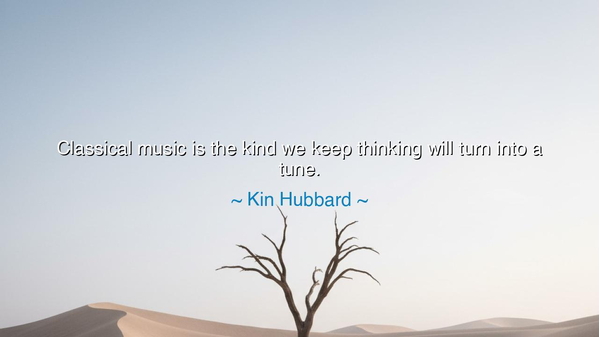
Classical music is the kind we keep thinking will turn into a






Kin Hubbard, the American humorist, once said with wit and gentle mischief: “Classical music is the kind we keep thinking will turn into a tune.” At first hearing, this sounds like a jest at the expense of the great masters—Bach, Mozart, Beethoven, Brahms. Yet within the laughter lies an ancient question: what is music, and how do we know when it becomes a “tune”? Hubbard’s words speak to the gap between the casual listener and the learned ear, between simplicity and sophistication, between popular melody and the lofty heights of classical music.
To call classical music the kind that never quite “turns into a tune” is to confess how foreign it may seem to those who seek immediate melody. For in truth, much classical music is not built upon short refrains that repeat like folk songs or pop choruses, but upon long journeys of theme and variation, harmony and counterpoint. The listener, untrained, waits for the “catchy part,” yet instead is drawn into a vast architecture of sound. To them, it seems as if the tune never arrives—yet for the attentive, the tune has been there all along, woven into layers too rich to grasp at once.
This jest hides a deeper truth about the nature of art. Humanity often clings to what is simple, familiar, and immediately gratifying. Yet the greatest works demand patience, discipline, and humility. A symphony is not a tavern song; it is a cathedral of sound. Hubbard’s words remind us that for many, classical music remains a puzzle, because its beauty is not always obvious—it is discovered slowly, as one learns to listen not only with the ear, but with the heart.
Consider the story of Beethoven’s Ninth Symphony. When first performed, many in the audience were bewildered by its length and complexity. They may have asked themselves: where is the “tune”? Yet within that work lies the immortal “Ode to Joy,” one of the most powerful melodies ever written. The path to that melody, however, is long and storm-tossed, filled with tension and struggle. The grandeur of the piece comes not only from the joy of its climax, but from the journey that leads to it. The casual listener may wait impatiently, but the one who endures finds treasure beyond measure.
Hubbard’s humor also reveals the distance between the popular and the profound. **Folk songs, blues riffs, country tunes—**these seize the heart in moments. They are no less noble, for they capture the spirit of the people. But classical music represents another pursuit: the attempt to capture the cosmos in sound, to reflect eternity in phrases too vast to be reduced to a “catchy tune.” His words therefore poke fun at the impatience of the uninitiated, while also exalting the grandeur of music that demands more than simple listening.
The lesson, then, is this: do not despise what is not immediately understood. Whether in music, literature, or life, the deepest truths are often those that unfold slowly. Train your ears for patience, your heart for openness, and your mind for curiosity. Do not wait only for the “tune”—seek the journey, the textures, the hidden themes, the subtle harmonies. In doing so, you will find beauty where once there was only confusion.
So, O seekers of wisdom, take Hubbard’s jest as counsel. Laugh at the truth of it, yes, but let the laughter guide you to humility. If you cannot yet hear the tune in classical music, listen again, and again, until you learn to hear not just melody but majesty. For the tune is there—it has always been there—waiting for the heart that is patient enough to discover it.
Thus remember always: the greatest treasures are not those that strike us at once, but those that reveal themselves in time. Classical music is such a treasure. It may seem to wander, to delay, to refuse to turn into a tune—but to those who wait, it becomes not a single melody, but a universe of them, each richer than the last.






AAdministratorAdministrator
Welcome, honored guests. Please leave a comment, we will respond soon